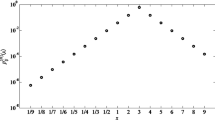Abstract
Pairwise comparison is a popular assessment method either for deriving criteria-weights or for evaluating alternatives according to a given criterion. In real-world applications consistency of the comparisons rarely happens: intransitivity can occur. The aim of the paper is to discuss the relationship between the consistency of the decision maker—described with the error-free property—and the consistency of the pairwise comparison matrix (PCM). The concept of error-free matrix is used to demonstrate that consistency of the PCM is not a sufficient condition of the error-free property of the decision maker. Informed and uninformed decision makers are defined. In the first stage of an assessment method a consistent or near-consistent matrix should be achieved: detecting, measuring and improving consistency are part of any procedure with both types of decision makers. In the second stage additional information are needed to reveal the decision maker’s real preferences. Interactive questioning procedures are recommended to reach that goal.
Similar content being viewed by others
References
Aguarón J, Moreno-Jiménez JM (2003) The geometric consistency index: approximated thresholds. Eur J Oper Res 147: 137–145
Bana e Costa CA, Vansnick J-C (2008) A critical analysis of the eigenvalue method used to derive priorities in AHP. Eur J Oper Res 187: 1422–1428
Bozóki S, Rapcsák T (2008) On Saaty’s and Koczkodaj’s inconsistencies of pairwise comparison matrices. J Glob Optim 42(2): 157–175
Bozóki S, Fülöp J, Poesz A (2010) On pairwise comparison matrices that can be made consistent by the modification of a few elements. Cent Eur J Oper Res. doi:10.1007/s10100-010-0136-9
Choo EU, Wedley WC (2004) A common framework for deriving preference values from pairwise comparison matrices. Comput Oper Res 31: 893–908
Cogger KO, Yu PL (1985) “Eigenweight vectors and least distance approximation for revealed preference in pairwise weight ratios”. J Optim Theor Appl 46: 483–491
Crawford G, Williams C (1985) A note on the analysis of subjective judgment matrices. J Math Psychol 29: 387–405
Fichtner J (1986) On deriving priority vectors from matrices of pairwise comparisons. Socioecon Plann Sci 20: 341–345
Gass SI, Rapcsák T (2004) “Singular value decomposition in AHP”. Eur J Oper Res 154: 573–584
Golany B, Kress M (1993) “A multicriteria evaluation of methods for obtaining weights from ratio-scale matrices”. Eur J Oper Res 69: 210–220
Koczkodaj WW (1993) A new definition of consistency of pairwise comparisons. Math Comput Model 18(7): 79–84
Lin C-C (2007) A revised framework for deriving preference values from pairwise comparison matrices. Eur J Oper Res 176: 1145–1150
Peláez JI, Lamata MT (2003) A new measure of consistency for positive reciprocal matrices. Comput Math Appl 46: 1839–1845
Saaty TL (1980) The analytic hierarch process. McGraw Hill, New York
Saaty TL (2005) The analytic hierarchy and analytic network processes for the measurement of intangible criteria and for decision-making. In: Figueira J, Greco S, Ehrgott M (eds) Multiple criteria decision analysis: state of the art surveys. Springer, New York, pp 345–407
Shirland LE, Jesse RR, Thompson RL, Iacavou CL (2003) Determining attribute weights using mathematical programming. Omega 31: 423–437
Srdjevic B (2005) Combining different prioritization methods in the analytic hierarchy process synthesis. Comput Oper Res 32: 1897–1919
Stein WE, Mizzi PJ (2007) The harmonic consistency index for the analytic hierarchy process. Eur J Oper Res 177: 488–497
Temesi J (2006) Consistency of the decision maker in pairwise comparisons. Int J Manage Decis Mak 7: 267–274
Tsoukias A (2008) From decision theory to decision aiding methodology. Eur J Oper Res 187: 138–161
Wedley WC (2008) From no thing to some things—deriving ratio preferences. 19th International Conference on MCDM, Auckland, pp 32–33
Xu Z, Wei C (1999) A consistency improving method in the analytic hierarchy process. Eur J Oper Res 116: 443–449
Author information
Authors and Affiliations
Corresponding author
Additional information
The research was partly supported by the Hungarian National Research Fund, Grant K 77420.
The first version of this paper was presented at the 19th International Conference on Multiple Criteria Decision Making in Auckland, New Zealand, January 2008. This revised paper used valuable comments from an anonymous reviewer.
Rights and permissions
About this article
Cite this article
Temesi, J. Pairwise comparison matrices and the error-free property of the decision maker. Cent Eur J Oper Res 19, 239–249 (2011). https://doi.org/10.1007/s10100-010-0145-8
Published:
Issue Date:
DOI: https://doi.org/10.1007/s10100-010-0145-8




